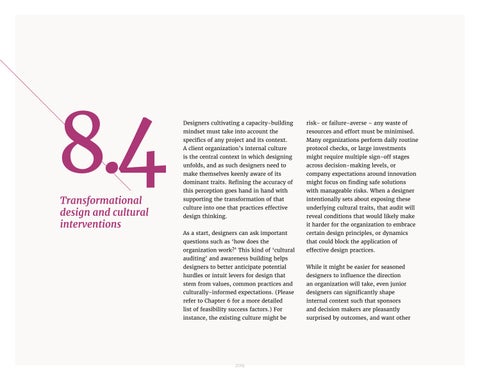8.4 Transformational design and cultural interventions
Designers cultivating a capacity-building
risk- or failure-averse – any waste of
mindset must take into account the
resources and effort must be minimised.
specifics of any project and its context.
Many organizations perform daily routine
A client organization’s internal culture
protocol checks, or large investments
is the central context in which designing
might require multiple sign-off stages
unfolds, and as such designers need to
across decision-making levels, or
make themselves keenly aware of its
company expectations around innovation
dominant traits. Refining the accuracy of
might focus on finding safe solutions
this perception goes hand in hand with
with manageable risks. When a designer
supporting the transformation of that
intentionally sets about exposing these
culture into one that practices effective
underlying cultural traits, that audit will
design thinking.
reveal conditions that would likely make it harder for the organization to embrace
As a start, designers can ask important
certain design principles, or dynamics
questions such as ‘how does the
that could block the application of
organization work?’ This kind of ‘cultural
effective design practices.
auditing’ and awareness building helps designers to better anticipate potential
While it might be easier for seasoned
hurdles or intuit levers for design that
designers to influence the direction
stem from values, common practices and
an organization will take, even junior
culturally-informed expectations. (Please
designers can significantly shape
refer to Chapter 6 for a more detailed
internal context such that sponsors
list of feasibility success factors.) For
and decision makers are pleasantly
instance, the existing culture might be
surprised by outcomes, and want other
209
